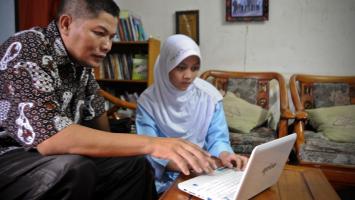Preparing Asia–Pacific’s Workforce for the AI Future

President, Asia–Pacific, Google

About 58% of people in Asia–Pacific are excited about AI’s potential but only 15% have received AI training and most are unaware this type of training exists, according to a new report from AVPN. Photo credit: ADB.
A total of 49 social impact organizations will receive funding from a fund aiming to help the region's workforce unlock the opportunities of AI.
This article is published in collaboration with Google.
Artificial intelligence (AI) presents a significant opportunity for economic growth and workforce transformation in Asia and the Pacific. But many people do not have the skills they need to make the most of this opportunity. About 58% of people in Asia–Pacific are excited about AI’s potential but only 15% have received AI training and most are unaware this type of training exists, according to a new report from AVPN, a network of social investors. This illustrates the critical need for the Google.org AI Opportunity Fund: Asia–Pacific. Our goal is to help everyone in the region unlock the opportunities of AI.
Today, we are introducing the 49 social impact organizations that will receive funding from the first phase of the fund, selected by AVPN through their open call and supported by the Asian Development Bank (ADB). Asia–Pacific’s rapidly growing workforce of 2 billion people is incredibly varied in language, culture, and economic context. The organizations will provide localized AI training and resources to those who need it most—from “solopreneurs” in rural parts of India to migrant domestic workers in Singapore to people with disabilities and their caregivers in Japan. The programs include practical AI uses tailored to each local market for more relevant and effective training. This targeted approach will help bridge existing gaps in AI-related workforce development to help ensure no one is left behind.
Today Google.org is also announcing the expansion of the Google.org AI Opportunity Fund by $12 million, to help more workers, small businesses, and nonprofits make the most of AI in their communities.
This includes $10 million in additional support to AVPN to continue equipping Asia–Pacific workers for the changing job market, with the goal to train 720,000 workers and 100,000 micro, small and medium-sized enterprises (MSMEs) across the region. MSMEs are the backbone of Asia-Pacific's economy, representing 96% of all companies, and employing up to 80% of the workforce. Yet research shows many struggle with AI skills development due to limited training accessibility, lack of access to digital infrastructure, and constrained financial resources.
It also includes a $2-million grant to Infoxchange to reach 10,000 nonprofits in the region with AI training and tools, including on recent Gemini features launched in Google for nonprofits products. This will help these organizations use AI for social good and create positive change in their communities.
A shift toward an AI-powered economy needs to be fair and inclusive, so all workers have the necessary knowledge and tools to participate. Through the Google.org AI Opportunity Fund: Asia-Pacific and our ongoing collaborations, we are committed to making sure everyone can benefit from the potential of AI.
This article was first published by Google on 5 May 2025.

Sanjay Gupta
President, Asia–Pacific, GoogleSanjay Gupta is president of Google's Asia–Pacific business, a region home to over 50% of the world's internet users. He previously led Google India with 3 decades of experience in Asia's diverse markets across media, telecoms, and fast-moving consumer goods. He is focused on technology trends, responsible technology development, and AI's potential for addressing global challenges.

Google's mission is to organize the world’s information and make it universally accessible and useful.

